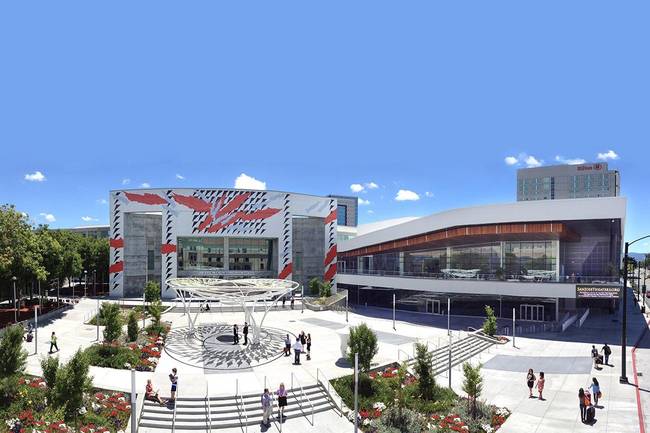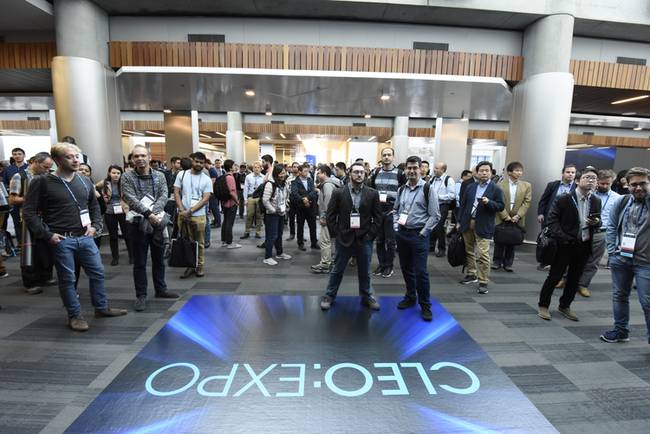Scalable quantum computing. Multiphoton microscopy for noninvasive brain imaging. The latest chapter on laser-matter interactions. These subjects and more are among the highlights of CLEO 2019, which is set to convene May 5-10 at the San Jose McEnery Convention Center.
CLEO highlights the latest applications, market-ready technologies, and cutting-edge research in all areas of lasers and photonics with six days of technical sessions, tutorials, exhibits, special symposia, short courses, plenary sessions, and other special events.

San Jose McEnery Convention Center. Courtesy of San Jose Convention & Visitors Bureau.
Plenary speakers will include Chris Xu, professor of applied and engineering physics at Cornell University, founding co-director of Cornell Neurotech, and director of Cornell NeuroNex Hub, an NSF funded center for developing and disseminating neurotechnology. Xu’s presentation, “Imaging Deeper and Faster: Watching the Brain in Action with Ultrafast Lasers,” will address how nonlinear optical microscopy enables noninvasive monitoring of brain activity in live animals on a large scale. Xu was a contributor to the early development of multiphoton microscopy.
Another notable plenary speaker is Christopher Monroe, professor at the University of Maryland and chief scientist at IonQ Inc. His presentation, “Quantum Computing with Atoms,” discusses atoms as the highest-quality components for a scalable quantum computer, with unmatched coherence properties and reconfigurable circuits that are “wired” with laser beams. Monroe will contemplate the future of this field and the critical role lasers and optics will play. In 1995, Monroe led the NIST team that demonstrated the first quantum logic gate and exploited the use of trapped atoms for the first controllable qubit demonstrations.
Naomi J. Halas of Rice University, the first person to demonstrate that the shape of plasmon-supporting metallic nanoparticles determines their color, is also among the esteemed plenary speakers. Her presentation is “Plasmonics: Putting Light to Work from the Dipole Up.”
Extreme Light
Two of the three 2018 Nobel Laureates in Physics — Arthur Ashkin and Gérard Mourou — will discuss how extreme-light laser has the possibility to shed light on some of the remaining unanswered questions in fundamental physics, such as the genesis of cosmic rays with energies in excess of 1020 eV, or the loss of information in black holes. Using wake-field acceleration, some of these fundamental questions can be studied in the laboratory. In addition, extreme-light enables study of the structure of vacuums and particle production in "empty" space, which is one of the field's ultimate goals. Their discussion is titled “Passion for Extreme Light.”
The third 2018 Nobel Laureate in Physics, Donna Strickland, of the University of Waterloo in Canada, will lead a discussion on the new types of interactions now possible between light and matter, including a laser that can deliver short pulses of light that knock electrons off their atoms. New understanding of laser-matter interactions has led to developments including new machining techniques that are used in laser eye surgery and micromachining of glass used in cellphones. Her presentation is “Generating High-intensity, Ultrashort Optical Pulses.”
A review of the multibillion-dollar race to integrate complex, high-performance optoelectronic systems into automobiles will be presented by Mial Warren, vice president of technology at TriLumina Corp., in his discussion, “A Lidar in Every Garage: The Race for Automotive Optical Sensor Supremacy.”
Tutorial speakers will give presentations that cover three general topic areas: Applications & Technology, Fundamental Science, and Science & Innovations. More than 20 tutorial speakers will present in-depth discussions with new subcategories this year, including “Quantum Photonics” in Fundamental Science, and “Quantum and Atomic Sensors, and Their Applications” in Science & Innovations.
The subcommittee for “Quantum Photonics” will look at the generation, detection, characterization, and application of faint light. This includes single-photon and few-photon quantum states, as well as supporting optical technologies for their realization.
The committee for “Quantum and Atomic Sensors, and Their Applications” will look at new research in the area of quantum and atomic sensors, including advances in device development and sensitivity, applications to precision and physical measurement, and technologies that support their integration and instrumentation.
CLEO will feature 200 companies exhibiting new products and demonstrating cutting-edge innovations.

CLEO Exhibition Hall entrance.
Courtesy of CLEO.
A new addition to CLEO 2019 are topical workshops to be led by panels of specialists, which will provide a conversational atmosphere. They will address technical and tactical questions not covered in the traditional presentations. Workshop topics will focus on the realistic possibility of universal quantum computing, thought-provoking ideas to improve diversity in the hard sciences, and the commercial future of optical frequency combs.
For the parents who would like to attend the full conference, CLEO has partnered with KiddieCorp to offer on-site free childcare. CLEOkids is offered for children ages 6 months to 12 years from Monday through Friday for all registered attendees who complete advanced registration.
Be a part of the CLEO event for 2019 and experience the front-end of research and development in the laser science industry. For more information and to register, please visit www.cleoconference.org/home.